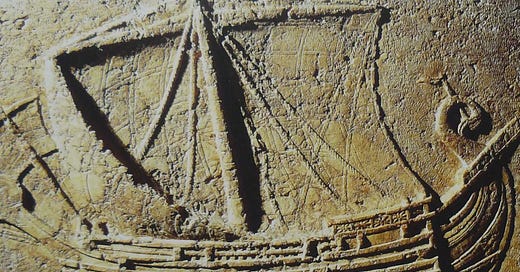Fresh Batch #22: The Black Stone & Abecedaria
Is It The Oldest Roman (Latin) Inscription?
My readers know how I feel about archeological “discoveries” over the last few centuries. I am skeptical, to say the least. From Guillermo Carvajal, “In 1898 the Venetian archaeologist Giacomo Boni was appointed director of the excavations of the Roman Forum at the Italian capital, a position he held until his death in 1925. Among the discoveries he made during that period are an Iron Age necropolis, the Regia (first a barracks and then the seat of Rome’s highest pontiff), the temple of Vesta and other monuments.
One of its most outstanding discoveries in the Forum is the Lapis Niger (black stone in Latin), an ancient sanctuary where one of the first known Latin inscriptions was found, dated between 570 and 550 BC.”
If true, this is one of the earliest Roman Inscriptions. However, there are some interesting qualities about it, observed by Guillermo. He wrote, “As far as the inscription is concerned, it is, as we said, the oldest known so far in Latin. But it has a number of particularities. Firstly, the alphabet with which it is written is more similar to Greek than to Latin, (I disagree; it looks Etruscan) which places it chronologically at the origins of the latter. Then, it is written in boustrophedon, an archaic type of writing that consists of writing one line from left to right and the next from right to left or vice versa.
And finally, the interpretation of what it says is limited because the beginning and the end of the inscription are missing and the rest is only half of each line. But what can be read seems to indicate that the site was dedicated to a king (rex). The transcription of the four faces of the pillar would be:
QVOI·HOI·SAKROS·ES·ED·SORD
OKAFHAS·RECEI·IO·EVAM·QVOSRE
M·KALATO·REM·HAB·TOD·IOUXMEN·TA·KAPIA·DOTAV
M·I·TERPE·M·QVOI·HA·VELOD·NEQV·IOD·IOVESTOD
And the generally accepted translation:
Whosoever (will violate) this (grove), let him be cursed. (Let no one dump) refuse (nor throw a body …). Let it be lawful for the king (to sacrifice a cow in atonement). (Let him fine) one (fine) for each (offence). Whom the king (will fine, let him give cows). (Let the king have a —) herald. (Let him yoke) a team, two heads, sterile … Along the route … (Him) who (will) not (sacrifice) with a young animal … in … lawful assembly in grove ..”
Pay attention to the red arrows. That’s how Boustrophedon is read.
Boustrophedon writing style is a technique found in the ancient universal empire. Do you know who else practiced it? To come to a deep understanding of what I’m about to share with you, read Spirit Whirled: The Holy Sailors. If you’ve already read it, you’ll appreciate what’s waiting for you in the rest of this post.
Become a member to access the rest of this article.
Keep reading with a 7-day free trial
Subscribe to Ancient History, Mythology, & Epic Fantasy to keep reading this post and get 7 days of free access to the full post archives.








